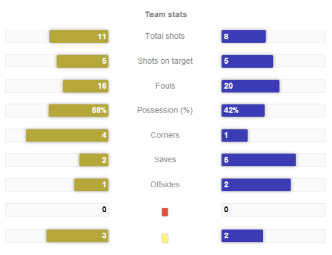As much as possible, I avoid making predictions about which team will win the World Cup. First of all, I’m not a psychic animal and second, football is really just unpredictable and stochastic. I could probably do the math, but I prefer just to enjoy watching the games.
You may ask, “Could you not tell which team would win?” Yes, you can tell who will “probably” win, but you cannot tell which team will actually win. Tell that to the Dad who wagered his child’s life savings. You can try predicting but some teams will just pull a surprise and that is what makes football such an exciting game! Anything can happen!

Before the World Cup started mathematical models and World Cup experts ranked the favorites that could win the coveted prize. Hosts Brazil ranked number 1 for a number of reasons including home support. Defending Champions Spain was also heavily favored [1]. As we all know, Brazil was knocked out by the German’s Blitzkrieg by a score of 7-1 in the semis. Spain on the other hand, didn’t even get through the group stages.
So what messes up the mathematical models? These models admit that they cannot account for changes in the personnel in case of an injury. It also does not account for a refereeing decision that can influence an entire match. And, it does not account for a sudden change in the tactics of the other team. Neymar, broke a vertebrae and Thiago Silva had two yellow cards which made him unavailable for the semis. Portugal’s Pepe received a red card vs Germany. That found them a man less and they got beaten 4-0 which eventually led to their early departure from the Mundial. Spain could no longer rely on Tiki-Taka as they got defeated by more direct approaches to football. And when games end tied even after extra time, teams go into the “lottery” of penalties.
Football, Probability and Statistics 101
Here are some questions we should ask ourselves in making a mathematical prediction: 1.) How do we rate the international football teams [2]? 2.) What variables are important in considering the quality of the team? 3.) How do we make sense of all these data?
Rankings and Ratings
There are a number of ranking methods out there but I personally refer to the FIFA ranking [3] which is determined by the number of points gained from winning and drawing matches over a period of time. The number of points is determined by the product of the match result points (3 for win, 1 for a draw, 0 for loss, 2 for win via penalties), the importance of the match, the strength of the opposing team and the strength of the confederation (with Europe’s UEFA and South America’s CONMEBOL being the strongest).
For the sake of discussion we’ll be focusing on the Soccer Power Index. I also think that this is a better measure of how a team will fare if the match were to be played tomorrow. Unlike other rating systems, SPI accounts for margin of victory and home-field advantage plus player ratings based on club competitions they participated in internationally. So both the performances or the quality of playing styles of the teams and the quality of the lineup. This is nice because the number of international games is quite limited and thus the sample is quite small. [4] [5]

At the half-time period or at the end of the full match, the game statistics are normally shown. Let me give you a feel on why some of these stats are worth looking at.
Total shots – The team that takes more chances are the ones who normally make more goals. But of course this is not always true because some shots may be inaccurate or the other team has a really good keeper. Just recall the game last season between Borussia Dortmund and Borussian Mönchengladbach. Dortmund had 27 shots compared to Gladbach’s 6 and yet the former was beaten by two goals to nil thanks to wasted Dortmund chances and an impeccable performance by Marc Andre Ter Stegen, Gladbach’s former GK.
Shots on target– This is a more important measure of a team’s offensive prowess. Defensive teams may choose to “park the bus” to limit more offensive teams in this area.
Possession – Spain is known for its possession-based tiki-taka football. The idea behind the importance of possession is best summarized by Pep Guardiola [2]
“Everything starts with the ball and finish with the ball. So, sometimes we forget that this is a game 11-11, with one ball. And we try to keep this ball, we try to play with the ball, we try to make everything with the ball.”
To explain further, if you have the ball then you can score goals and more possession also means that the opposing team has less chances to take advantage of. Unfortunately for fans of possession-based football, efficient counter-attacking and more direct plays have provided the Kryptonite to this previously unbeaten footballing philosophy. The team that makes the most out of the time with the ball, not the team that keeps it longer, will win the match [7].
Corners, free kicks and penalties are also nerve-wracking moments in the match. It seems that these stats do not guarantee which team will win. Then why bother with them at all? These stats can also give teams clues on what aspects they need to improve on. Plus, it’s also fun when your model gets the right prediction a statistically significant amount of times and when a less favored team beats the odds!
Why people all over the world are crazy about football
The unpredictability of football, the feints, the dribbles, the magisterial rockets of a goal, tackles and the saves all contribute to the emotions that affect both players and fans alike.
The finals of the 2014 FIFA World Cup was held in the Maracana Stadium in Rio de Janeiro in Brazil. Millions of people around the world were hooked on the screens, and about a hundred thousand people carrying Argentinean and German flags watched live.
This year’s world cup, was dubbed as the most exciting World Cup of all. Probably one of the reasons why this was so exciting was because low-rated teams performed beyond expectation. Costa Rica emerging as group winners was a surprise. They ousted highly-rated and historically great teams Italy and England. The USMNT surprisingly also got to the quarterfinals thanks to their good performance and some luck. Then there are the last-minute goals, the wins determined by extra time and the penalties.
Football gives you that thrill and it can teach people about probability and statistics. Although, I don’t think the latter’s the reason why they watch. Nothing is for certain in football. You can tell to some extent who’s more likely to win but that’s about it. If you absolutely knew who would win, then it wouldn’t be so heart-racing and exciting! The World cup is simply the greatest sporting event there is!
Germany, the better team, won the World Cup. Too bad Argentina was not able to capitalize on their clear chances in front of the goal. I guess the little kid doesn’t have to worry about his savings anymore.
References:
[1] http://www.goldmansachs.com/our-thinking/outlook/world-cup-sections/world-cup-book-2014-statistical-model.html
SPI model
[2] http://fivethirtyeight.com/features/its-brazils-world-cup-to-lose/
[3] http://www.fifa.com/worldranking/procedureandschedule/menprocedure/
[4] http://espn.go.com/soccer/worldcup/news/_/id/4447078/GuideToSPI
[5] http://espn.go.com/soccer/worldcup/news/_/id/4504383/faq
[6] http://en.wikipedia.org/wiki/Pep_Guardiola
[7] http://www.soccerstatistically.com/blog/2011/7/27/does-more-possessionmore-wins-in-the-mls.html

